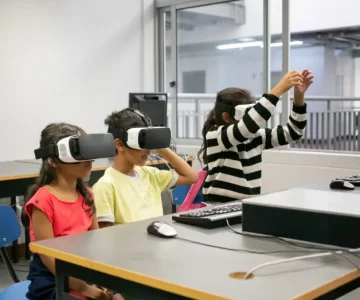In an age dominated by technology and distractions, keeping students engaged in the classroom is more challenging than ever. With the constant pull of social media, mobile notifications, and digital entertainment, teachers are facing an uphill battle to retain student attention. The question arises: How can we ensure that every minute spent in the classroom delivers the maximum learning value for students?
What is Learning Value Per Minute (LVPM)?
Learning Value Per Minute (LVPM) is a concept designed to measure the effectiveness of time spent on learning activities. It calculates how much knowledge or skill a student gains in a given timeframe, offering a metric to assess the impact of various teaching methods and technologies. While this approach can provide valuable insights into the efficiency of classroom practices, it’s important to remember that learning isn’t just about rapid knowledge acquisition. Emotional development, social skills, creativity, and critical thinking—areas that are harder to measure—are equally important but often don’t fit neatly into this formula.
The LVPM Formula
To calculate LVPM, we use a simple equation:
Learning Value Per Minute = Knowledge Gain ÷ Time Spent
Where:
- Knowledge Gain is determined by measuring students’ understanding through assessments, quizzes, or other interactive methods.
- Time Spent is the total minutes dedicated to active learning activities.
While LVPM offers a quantitative view of how efficiently time is used in the classroom, it’s essential to complement it with other metrics that capture the broader educational experience.
Strategies to Maximize LVPM
To truly optimize LVPM, educators need a balanced approach, blending traditional teaching methods with innovative, tech-driven tools. Here are a few time-tested strategies that can increase the learning value of every minute spent in class:
1. Case-Based Learning
Real-world case studies or scenario discussions encourage students to apply their knowledge in practical ways. By engaging with real-life problems, students build critical thinking and problem-solving skills, which enhances the overall learning experience, making each minute more valuable.
2. Peer Teaching
When students teach each other, they reinforce their own understanding. Peer teaching is particularly beneficial for complex subjects and can significantly improve knowledge retention. By actively engaging in teaching their peers, students contribute to their own learning, making their time in the classroom more efficient.
3. Flipped Classroom Model
The flipped classroom model turns the traditional setup on its head. Instead of using class time for lectures, students review materials at home and use classroom hours for active learning activities like discussions and group projects. This allows for more hands-on learning, which tends to have a higher LVPM compared to passive listening.
Integrating Technology to Boost LVPM
While traditional methods are essential, modern technology can significantly elevate LVPM. By incorporating tools like interactive 3D platforms and AI-powered tutors, students gain real-time feedback and immersive learning experiences that boost engagement and knowledge retention.
The Power of Interactive 3D Learning Platforms
Platforms like Axon Park, which integrate AI-Tutors with 3D virtual environments, are revolutionizing the learning process. These technologies are designed to enhance LVPM by increasing engagement and optimizing both knowledge gain and time spent learning.
1. Personalized Learning with AI
AI-powered tutors can adjust to each student’s learning style and pace. They can identify areas where students struggle and provide targeted exercises to address these gaps. This tailored approach ensures that every minute spent learning is as productive as possible.
2. Real-World Simulations in 3D Environments
Instead of reading about concepts or watching videos, students can apply their knowledge in a simulated environment. Whether it’s conducting virtual science experiments or solving complex engineering problems, these interactive 3D platforms enable students to engage with the material in a practical, hands-on way. This leads to faster knowledge application and improved LVPM.
3. Real-Time Engagement Tracking
Modern platforms can track students’ engagement using biometric data or activity logs, allowing instructors to adjust content or teaching methods on-the-fly to maintain high levels of participation. This ensures that students stay engaged and make the most of their learning time.
Measuring LVPM Impact
To determine whether these strategies are actually boosting LVPM, it’s crucial to have tools in place to measure their effectiveness. Here are some ways to evaluate the impact of various teaching methods:
1. Pre- and Post-Assessments
By measuring student performance before and after a lesson or activity, educators can directly calculate the knowledge gained. Dividing this by the time spent on the activity gives a clear LVPM score.
2. Long-Term Retention Studies
It’s important to consider how well students retain knowledge over time. Longitudinal studies that track student performance over weeks or months can provide insight into how different teaching methods affect long-term retention and LVPM.
3. Student Feedback
While LVPM focuses on measurable outcomes, qualitative data from students can provide additional insights. Surveys or interviews can help assess how students feel about the effectiveness and engagement of different teaching methods.
4. Time-Tracking Tools
For accurate measurement of Time Spent, educators can use time-tracking tools to monitor how much time students spend on various activities, both inside and outside the classroom. This ensures that the LVPM formula accurately reflects the time devoted to learning.
5. A/B Testing
Comparing different teaching methods or technologies in controlled settings can help identify which ones yield the highest LVPM. For example, comparing a traditional lecture-based class with one that uses interactive 3D platforms can provide valuable data on their relative effectiveness.
6. Data Analytics
Many modern educational platforms come with built-in analytics, providing a wealth of data about student engagement, performance, and participation. By analyzing these metrics, educators can continuously refine their strategies to maximize LVPM.
Conclusion
Maximizing the value of every minute students spend learning is more critical than ever. By combining proven teaching methods with innovative technologies, educators can significantly enhance LVPM, making learning more efficient and impactful. With the help of tools like AI-Tutors and interactive 3D platforms, the future of education is brighter, offering students a more personalized, engaging, and effective learning experience.





